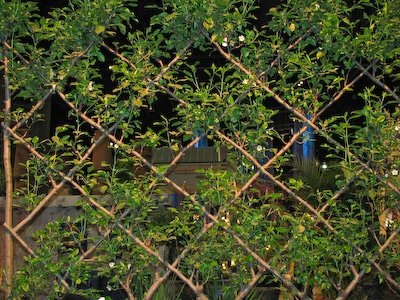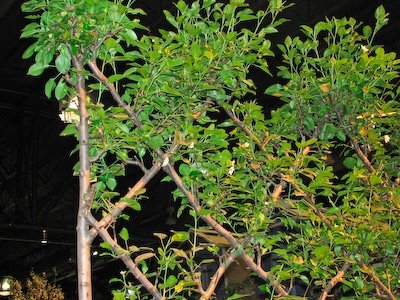This year CobraHead again exhibited at the Philadelphia Flower Show. While Anneliese, Noel and I spent most of our time in our booth in the vendor section extolling the virtues of our wares to the passing public, in the evenings I would get a chance to take in the splendid display gardens. Several truly impressed me, but I tend to spend the most time going back to the ones that inspire me to do something in my own garden.
This year The Chef’s Rooftop Garden display by Stoney Bank Nurseries did just that with its multiple espaliered fruit trees. Here is the one that I want to copy.
When I got back to Austin I immediately opened up Pruning by Robert Kourik. I learned that this particular style of espalier is known as a Belgian Fence. Kourik notes that even though some espalier styles are not optimal for encouraging fruiting, the Belgian Fence, having all branches at 45 degree angles, promotes fruiting.
I have a 12 foot section of cinder block wall that separates my porch from the front yard. I determined that I would need 7 pear trees planted on 2 foot centers to grow a living screen in front of this wall. I ordered one year old bare roots of Keiffer Pear trees from Bob Wells Nursery in Lindale, TX. I met the folks at Bob Wells Nursery while doing a show in Tyler back in February. Now, I’m going to be over a month late planting bare roots in Austin, but my travel schedule sometimes keeps me from doing everything in my garden when I should.
In the above picture, note how the outer tree has a vertical central leader and then one side branch at a 45 degree angle coming off the right side approximately every two feet. The central trees have only two central leaders each at a 45 degree angle and no side branches. The tree on opposite end has one central leader and then one side branch on the left side every two feet.
To fill in my 12 foot space, I determined that my middle tree should also have a vertical central leader and a symmetrical pattern of branches coming out both the left and right sides every two feet. I know it sounds confusing, but when I drew this out on graph paper it fills in the pattern perfectly. This trick now is to get these living trees to follow my idealized pattern.
Have any of you trained your fruit trees in espalier patterns? Please post a comment if you have.




It’s beautiful. Such patience and vision it takes.
Wow! thanks for sharing the possibilities : ]
I have a newly planted citrus Belgiam fence in West Australia. There is a pic of it on http://www.alfrescostyle.com
Regards Ian
Thank you for posting photo’s of the Belgian Fence Espaliers at the Philly Show.
These trees were trained at my nursery. River Road Farms in Decatur, TN. You can see more of them on my site at espaliertrees.com
After training espaliers for over 21 years, it still excites me to see that other people find them as special as I do. It’s a labor of love for me
If you love gardening and want a project. Learn to tree an espalier in your garden.
A good how to book. Pruning and Training Plants by David Joyce or search “An Espalier for Every Garden”. A story I wrote for Fine Gardening Magazine